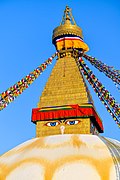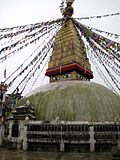List Of Stupas In Nepal
Ashoka's daughter Charumati, who married a Nepali prince, built Charumati Stupa in the 4th century. Boudhanath is one of the holiest sites in Nepal, it was closed for 18 months after the April 2015 Nepal earthquake, which completely destroyed the top part of the stupa. After the Annexation of Tibet by the People's Republic of China, many refugees from Tibet started to settle in the area and convert it into a "Little Lhasa". Kaathe Swayambhu, a replica of the Swayambhunath that was built in 1650, is located near Thamel. In Lumbini, the place where, according to Buddhist tradition, Queen Mahamayadevi gave birth to the Buddha, there are several stupas including World Peace Pagoda, Myanmar Golden Temple, and Great Drigung Kagyud Lotus Stupa.
The World Peace Pagoda was built by Japanese Buddhists for about US$1 million; near the stupa is the gravestone of a monk who was murdered by an anti-Buddhist group while the building was being built. The Ramagrama stupa contains the relics of the Buddha and it remains untouched in its original form. According to the legends, Ashoka came to the stupa with a plan to open it, however, when he got there a snake god ordered him "not to interfere with the site" so he started to worship the site. Four stupas are recognised as a World Heritage Site by the United Nations Educational, Scientific and Cultural Organization (UNESCO).
List of stupas
| † | Denotes UNESCO Heritage Site |
See also
- Buddhism in Nepal
- Newar Buddhism
- Maya Devi Temple, Lumbini
- Buddhist pilgrimage sites in Nepal
- List of Buddhist stotras in Nepalbhasha
- List of Mahaviharas of Newar Buddhism
- List of monasteries in Nepal
- Bahal, Nepal
References
- ^ Mark, Joshua J. (1 September 2020). "Stupa". World History Encyclopedia. Archived from the original on 8 September 2020. Retrieved 8 September 2020.
- ^ Láscar, Jorge (3 September 2020). "Swayambhunath Stupa". World History Encyclopedia. Archived from the original on 8 September 2020. Retrieved 8 September 2020.
- ^ Pant, Shaswat (13 October 2017). "Swayambhu: The eyes that keep watch over Kathmandu". OnlineKhabar. Archived from the original on 9 September 2020. Retrieved 9 September 2020.
- ^ "Charumati facelift". Nepali Times. January 2004. Archived from the original on 9 September 2020. Retrieved 9 September 2020.
- ^ Regmī, Jagadīśacandra (1972). Temples of Kathmandu. Culture Centre. OCLC 1504633. Archived from the original on 9 September 2020. Retrieved 9 September 2020.
- ^ "Nepal's earthquake-hit Boudhanath stupa reopens after restoration". The Guardian. 22 November 2016. Archived from the original on 9 September 2020. Retrieved 9 September 2020.
- ^ Sherwood, Seth (4 February 2009). "In Frenetic Katmandu, Finding a Quiet Space". The New York Times. ISSN 0362-4331. Archived from the original on 9 September 2020. Retrieved 9 September 2020.
- ^ Bhattarai, Sewa (28 December 2018). "The stupa of a million dewdrops". Nepali Times. Archived from the original on 8 September 2020. Retrieved 9 September 2020.
- ^ "Kathesimbhu Stupa". Lonely Planet. Archived from the original on 9 September 2020. Retrieved 9 September 2020.
- ^ Aryal, Suprasanna (22 May 2013). "Amidst Fluttering Prayer Flags" (PDF). Friday. Archived (PDF) from the original on 9 September 2020. Retrieved 9 September 2020.
- ^ "Lumbini, the Birthplace of the Lord Buddha". UNESCO World Heritage Centre. Archived from the original on 9 September 2020. Retrieved 9 September 2020.
- ^ "World Peace Pagoda". Lonely Planet. Archived from the original on 8 September 2020. Retrieved 9 September 2020.
- ^ Kandel, Prakriti (22 March 2019). "The Buddha was born in Lumbini". Nepali Times. Archived from the original on 8 September 2020. Retrieved 8 September 2020.
- ^ "Ramagrama Stupa". World Heritage Journeys. Archived from the original on 8 September 2020. Retrieved 9 September 2020.
- ^ Gutschow, Niels (1997). The Nepalese Caitya: 1500 Years of Buddhist Votive Architecture in the Kathmandu Valley. Edition Axel Menges. p. 92. ISBN 9783930698752. Archived from the original on 8 April 2014. Retrieved 8 April 2014.
- ^ "Boudhanath Stupa". Lonely Planet. Archived from the original on 8 September 2020. Retrieved 8 September 2020.
- ^ DHARLO, Nyanang Bhusepa Rinchen (1 January 2020). The Buddhist Holy Sites of Nepal: The Songs of Marvelous Conversation. Library of Tibetan Works and Archives. ISBN 978-93-87023-96-3. Archived from the original on 9 September 2020. Retrieved 8 September 2020.
- ^ Huntington, John C.; Bangdel, Dina (2003). The Circle of Bliss: Buddhist Meditational Art. Serindia Publications, Inc. ISBN 978-1-932476-01-9. Archived from the original on 9 September 2020. Retrieved 8 September 2020.
- ^ McDaniel, Justin Thomas (1 April 2017). Architects of Buddhist Leisure: Socially Disengaged Buddhism in Asia's Museums, Monuments, and Amusement Parks. University of Hawaii Press. ISBN 978-0-8248-7440-7. Archived from the original on 9 September 2020. Retrieved 8 September 2020.
- ^ "Exotic sites and wild creatures". Bangkok Post. 2 February 2020. Retrieved 8 September 2020.
- ^ Weismantel, Julia (21 July 2020). Kathmandu lieben lernen: Der perfekte Reiseführer für einen unvergesslichen Aufenthalt in Kathmandu inkl. Insider-Tipps, Tipps zum Geldsparen und Packliste (in German). BoD – Books on Demand. ISBN 978-3-7519-7362-5. Archived from the original on 8 September 2020. Retrieved 8 September 2020.
- ^ Reed, D.; McConnachie, J. (2002). The Rough Guide to Nepal. Music rough guide. Rough Guides. ISBN 978-1-85828-899-4.
- ^ Turner, Elen (24 January 2020). "10 Architectural Treasures to Visit in Nepal". Architectural Digest. Archived from the original on 8 September 2020. Retrieved 8 September 2020.
- ^ "Votive stupa". Archaeological Survey of India. Archived from the original on 8 September 2020. Retrieved 8 September 2020.
- ^ J Das, Hengul. "World Peace Pagoda". The Times of India. Archived from the original on 8 September 2020. Retrieved 8 September 2020.
- ^ Majupuria, Trilok Chandra; Majupuria, Indra (1979). Glimpses of Nepal: Ancient & Modern Glories of a Charming Country. Maha Devi. OCLC 475316611. Archived from the original on 8 September 2020. Retrieved 8 September 2020.
- ^ Reed, David (2002). The Rough Guide to Nepal. Rough Guides. ISBN 978-1-85828-899-4. Archived from the original on 9 September 2020. Retrieved 8 September 2020.
- ^ "World Peace Pagoda". World Heritage Journeys. Archived from the original on 8 September 2020. Retrieved 8 September 2020.










